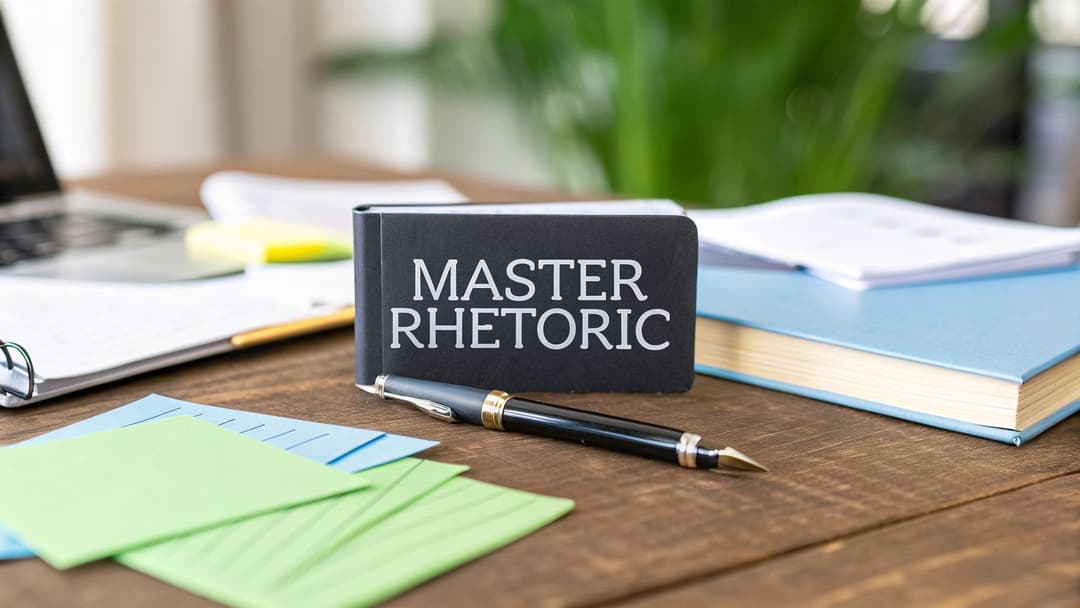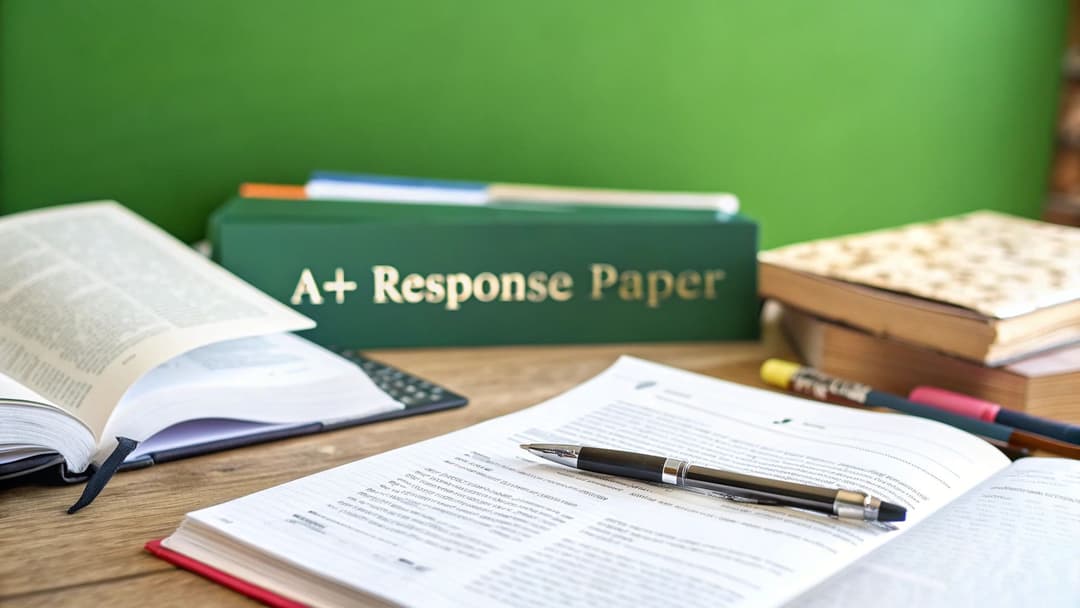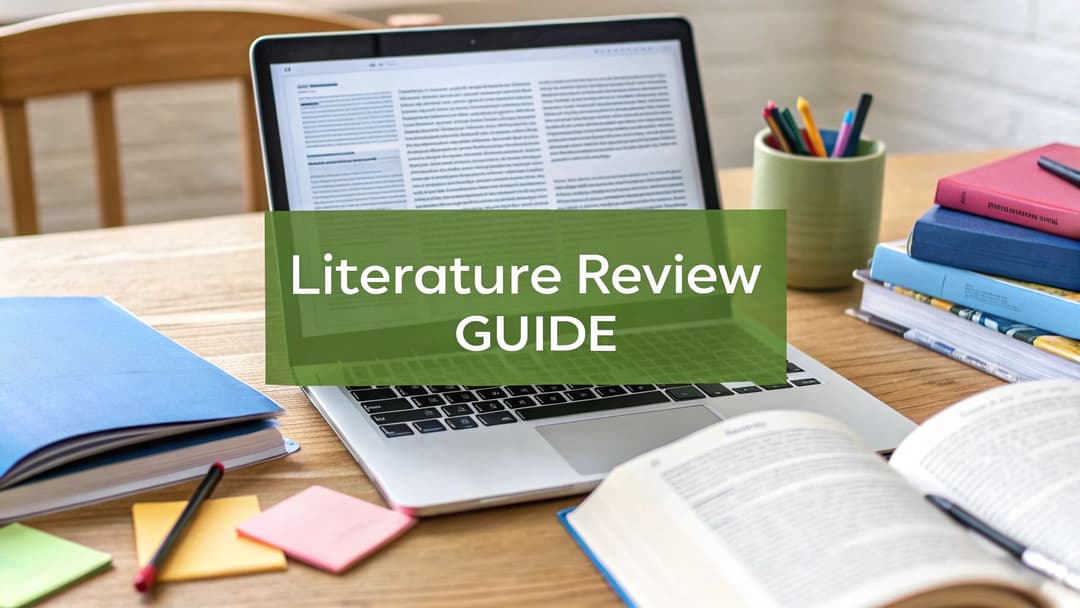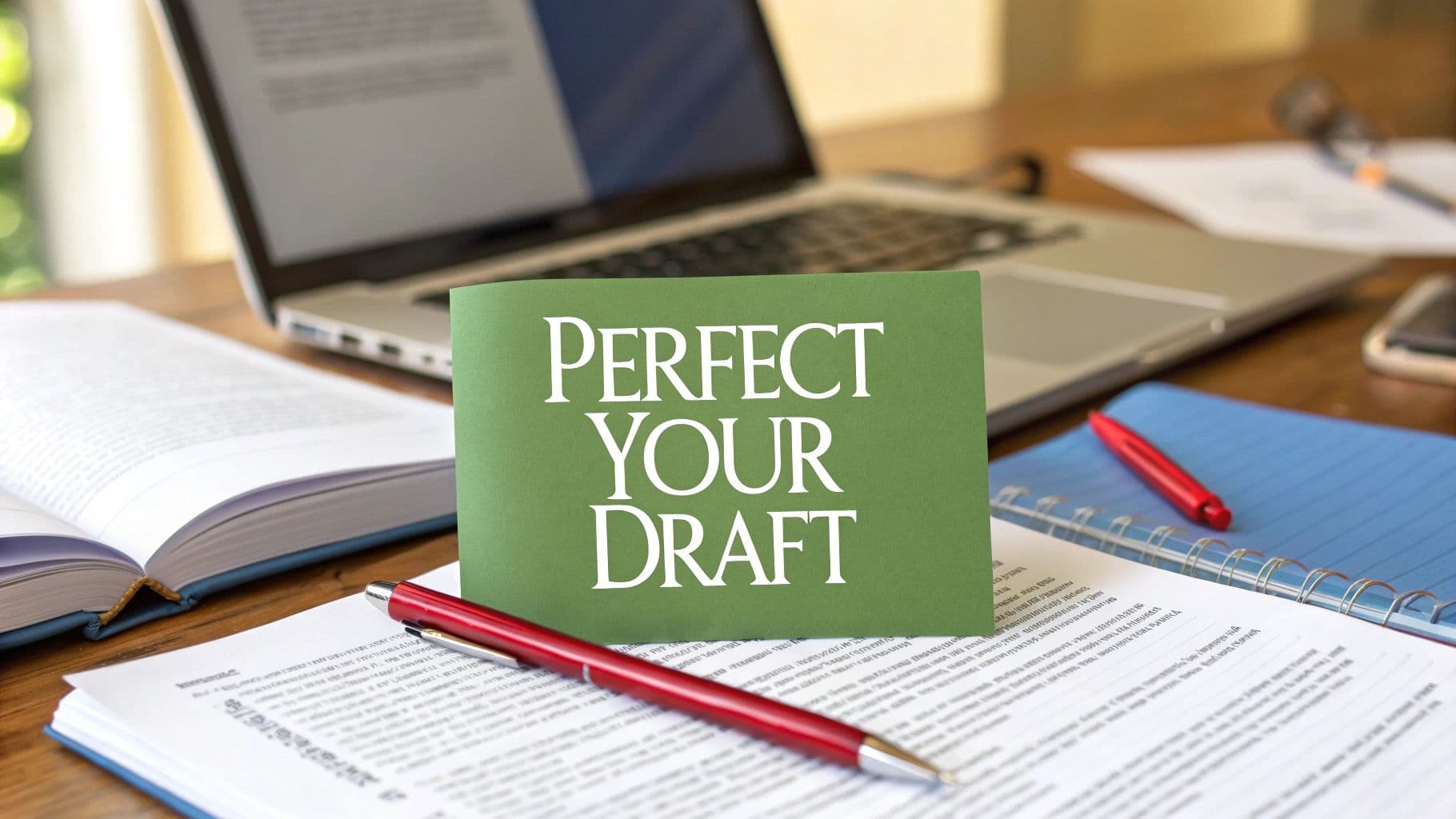
How to Edit a Paper: Tips to Perfect Your Draft
July 11, 2025
Don't think of editing as a single, overwhelming task. It’s actually a series of smaller, more focused steps. The biggest mistake I see people make—from students to seasoned professionals—is trying to fix everything at once.
When you're hunting for typos, questioning your argument, and rearranging paragraphs all at the same time, you're not doing any of it well. Your brain simply can't toggle between big-picture strategic thinking and detail-oriented proofreading effectively. This is why a phased approach isn't just a good idea; it's essential if you're serious about editing your paper the right way.
Your Strategic Editing Blueprint
Thinking of editing as one giant to-do item is a recipe for burnout and missed mistakes. It's much smarter to work in passes, with each pass having a single, clear goal.
This is all about working smarter, not harder. This strategic separation lets you dedicate your full attention to one part of the paper at a time, which dramatically improves the quality of your final draft.
The Four Phases of High-Quality Editing
A structured editing framework stops you from wasting time polishing a sentence that you might end up cutting later. The process should always flow from the big picture down to the tiny details—from your core ideas to the final comma.
For a deep dive into what to look for at each stage, our detailed self-editing checklist gives you a great step-by-step guide.
This simple workflow visualizes how to move from a broad overview to a final, detailed check.
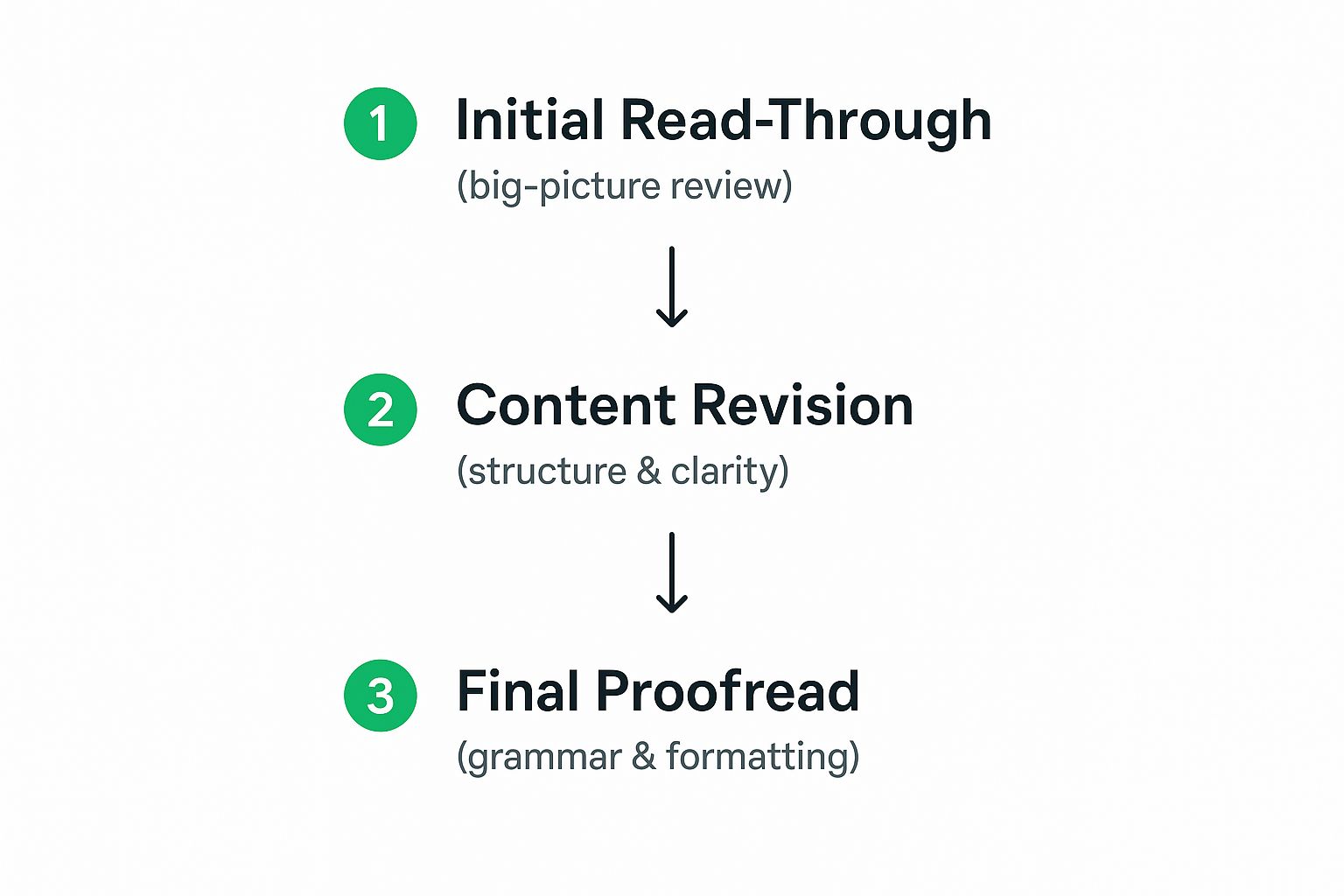
The image reinforces a crucial point: nail down your content and structure before you even think about hunting for typos.
By adopting this strategy, you give yourself a clear roadmap. Instead of staring at a wall of text wondering where to start, you have a defined entry point and a logical path forward. It’s how you turn a rough draft into a polished, persuasive, and professional document.
Key Takeaway: Treat editing like building a house. You wouldn't paint the walls before the foundation is secure and the framing is complete. Similarly, you shouldn't polish sentences until your paper's structure and arguments are solid.
To help you stay on track, I've put together a table that breaks down the four distinct phases of editing. Use it as your guide to focus your energy and make sure nothing slips through the cracks.
The Four Phases of Effective Paper Editing
This table breaks down the distinct editing stages, outlining their primary focus and the best time to tackle them for maximum impact.
| Editing Phase | Primary Focus | Key Questions to Ask | Best Time to Perform |
|---|---|---|---|
| Developmental Edit | Big-Picture Ideas & Structure | Is my thesis clear? Does my evidence support my claims? Is the flow logical? | After finishing the first draft and taking a 24-hour break. |
| Line Edit | Style, Clarity & Flow | Are my sentences clear and concise? Is the tone consistent? Does it sound like me? | Once the structure and argument are finalized and feel solid. |
| Copy Edit | Grammar & Mechanics | Are there any grammatical errors, typos, or punctuation mistakes? | After the line edit is complete and the content is essentially locked. |
| Final Proofread | Formatting & Final Polish | Is the formatting correct (citations, margins, etc.)? Are there any sneaky typos? | The very last step before you hit "submit" or "print." |
Each stage builds on the one before it, ensuring your final paper is strong—from its core argument right down to the last period.
Strengthening Your Paper’s Core Argument
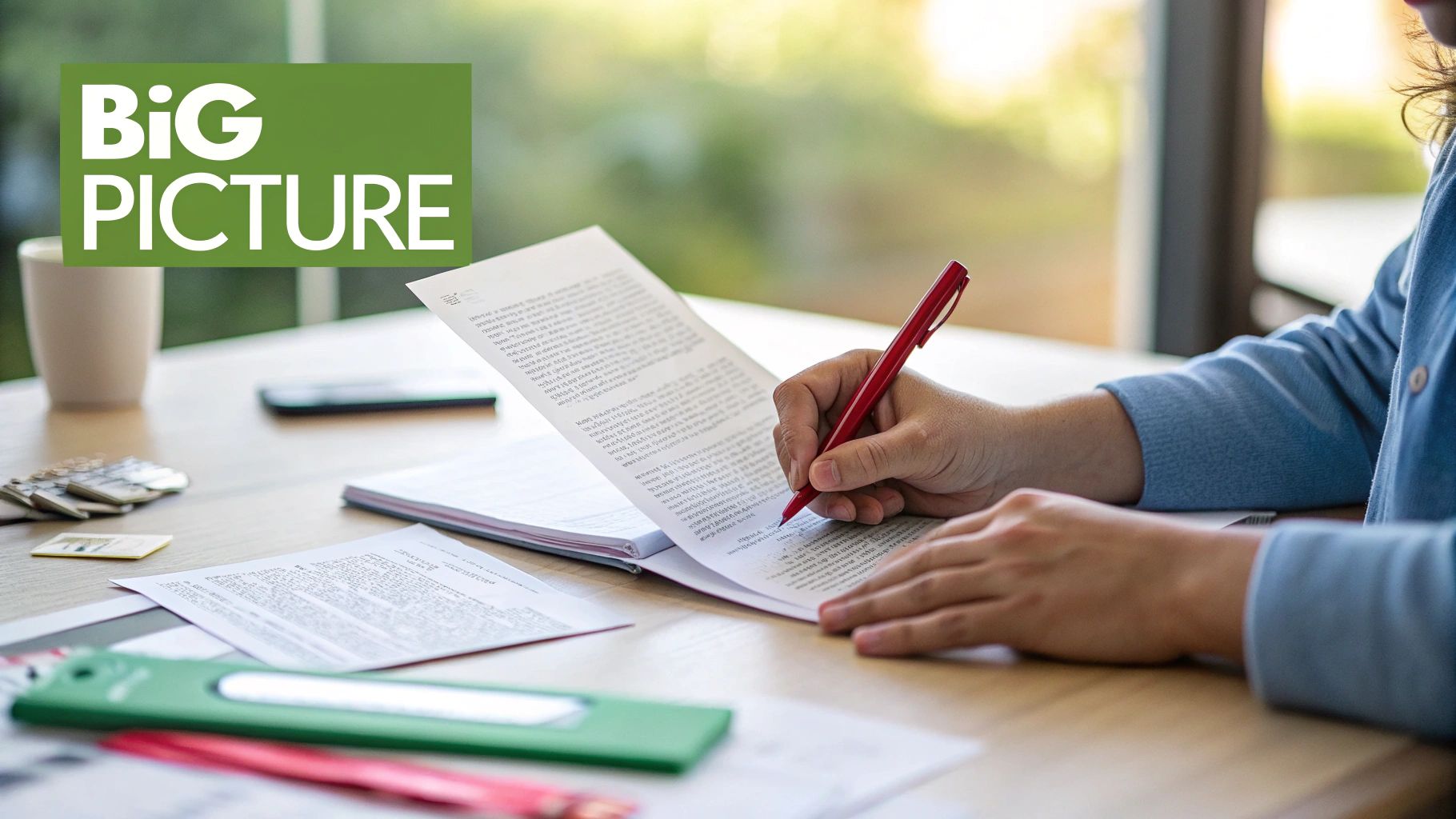
Before you even think about commas and word choice, you need to zoom out. This is the big-picture stage of editing, where you look at your paper’s foundation—its core argument, its structure, and the logical thread that ties it all together.
Think of it like an architect reviewing a blueprint. Is every support beam essential? Does the layout make sense? In the same way, you need to ask if every paragraph and piece of evidence actually holds up your central thesis. If something feels wobbly, it’s time for a major renovation, not just a fresh coat of paint.
Stress-Test Your Thesis Statement
Your thesis is the single most important sentence in your paper. It's the promise you make to your reader, and a vague or weak one will send your entire argument wandering off course.
Get tough and ask yourself these questions:
- Is it actually arguable? A thesis has to be a claim someone could reasonably disagree with. "Climate change is real" is a fact. "Implementing Policy X is the most effective strategy to mitigate climate change" is an argument.
- Is it specific enough? Vague statements kill good papers. Instead of something broad like, "Social media has an impact on society," narrow it down. Try something like, "The rise of algorithm-driven content on platforms like TikTok has fragmented public discourse by creating ideological echo chambers."
- Is it crystal clear? Use precise language. Your reader shouldn't have to guess what you mean.
A strong thesis is like a GPS for your reader. It tells them exactly where you're going and why the trip is worth taking. Without it, you’re just driving aimlessly.
This kind of clarity isn't just for academic papers. The global market for document editing services is on track to grow steadily through 2030, a trend fueled by the need for clear, high-quality writing in business, law, and countless other fields. It’s a skill that pays off. You can check out more details about this trend in this global market report.
Master the Reverse Outline
Once your thesis is rock-solid, you need to make sure the rest of your paper actually delivers on that promise. The best tool for this job is the reverse outline. Instead of outlining before you write, you build one from your finished draft.
It’s a surprisingly simple process:
- Go through your draft, one paragraph at a time.
- In a separate document, jot down the main idea or topic sentence for each paragraph.
- Number them so you know where each point came from.
This trick is like an x-ray for your paper’s structure. It immediately reveals any weaknesses. Are your points in a logical sequence? Does a paragraph feel random or redundant? Is a crucial part of your argument missing or underdeveloped?
This high-level view is especially vital when you need to know how to edit a research paper, where a single logical gap can sink your entire credibility. By making these bigger changes now, you avoid wasting hours polishing sentences in a paragraph that you were going to delete anyway.
Polishing Your Prose for Clarity and Style
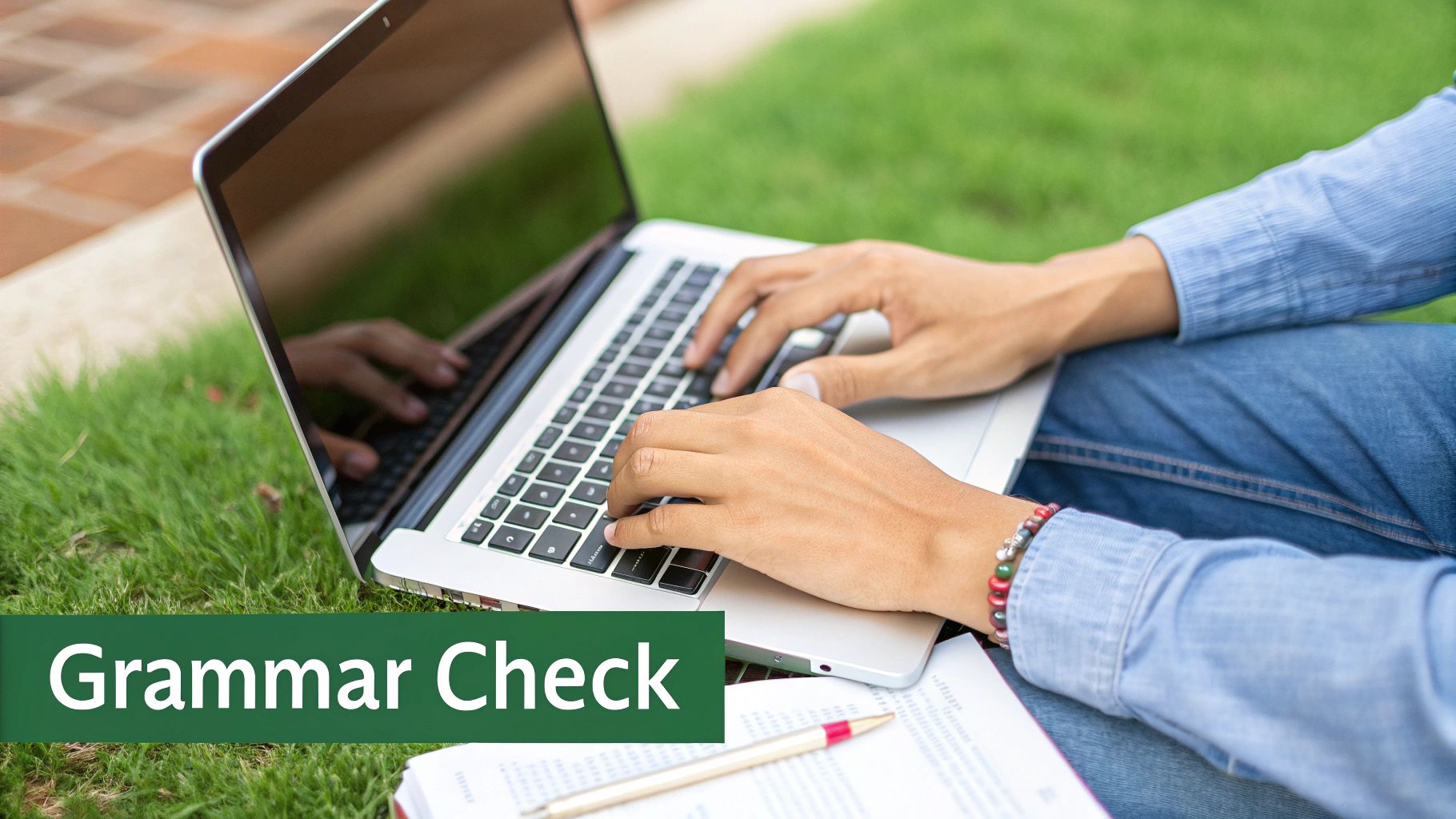
Alright, your argument is solid and the structure is locked in. Now it’s time to get your hands dirty at the sentence level. This is where you shift from being an architect to an interior designer, focusing on how each line reads and feels.
We’re talking about line editing. It’s the process that turns a paper that just says something into one that says it with confidence and style. This is where you make your writing sharp, clear, and genuinely engaging.
Think of it like sculpting. You're chipping away at every clunky phrase and unnecessary word to reveal the powerful message underneath.
Eliminate Wordiness and Passive Voice
The fastest way to tighten your writing is to hunt down and destroy wordiness. So often, clunky sentences are just weighed down by filler words and the passive voice. Switching to active voice is an instant fix that makes your writing more direct and energetic.
Here’s a classic example you’ve probably seen a thousand times:
- Passive: The experiment was conducted by the research team.
- Active: The research team conducted the experiment.
See the difference? The active version is shorter, punchier, and immediately tells you who did what. It has more energy.
Pro Tip: I like to do a "find and replace" search for passive flags like "was," "is," "are," and "were" when they're paired with a past-tense verb (think "was conducted" or "is shown"). Not every instance needs to be changed, but it’s a great way to spot sentences you can make more direct.
Strengthen Your Verbs and Vary Your Sentences
Strong verbs are the engines of good writing. Too often, we smother them with weak verbs and extra nouns, making our prose sound stiff and overly academic. Learning how to edit a paper for real impact means letting your verbs do the heavy lifting.
For example, instead of writing "make a decision," just say "decide." Ditch "perform an analysis" and use "analyze."
Weak vs. Strong Verb Choices
| Weak Construction | Strong Alternative |
|---|---|
| The results give an indication of… | The results indicate… |
| We will conduct an investigation into… | We will investigate… |
| She came to the conclusion that… | She concluded that… |
This one change alone adds a ton of punch and precision.
You also want to avoid monotonous writing. The trick is to vary your sentence length and structure. Mix short, direct sentences with longer, more descriptive ones. It creates a rhythm that pulls your reader along instead of putting them to sleep.
Cut Through Jargon and Clichés
Every field has its jargon, but leaning on it too much is a surefire way to lose your audience. Always ask yourself: Is there a simpler way to say this without dumbing it down? If you absolutely must use a technical term, just give a quick definition the first time you use it.
Clichés are the other enemy of fresh writing. These are the phrases we've all heard so many times they've lost all meaning.
Keep an eye out for tired expressions like:
- Think outside the box
- In this day and age
- At the end of the day
- It goes without saying
When you replace these with your own words, you show the reader you’ve put real thought into your writing. Polished prose signals a polished argument, and that level of care is what separates a good paper from a great one.
Using AI Editing Tools The Smart Way
Let's be honest, modern editing is a team sport. It's a partnership between your own critical thinking and the sharp precision of AI tools. Platforms like Grammarly or ProWritingAid have become a familiar part of the writing process, and for good reason. They’re fantastic at catching the kinds of mistakes our own brains—now far too familiar with the text—will glide right over.
These tools are your first line of defense. Think of them as a powerful filter, catching pesky typos, flagging obvious grammatical errors, and spotting style inconsistencies you’d otherwise miss. They clean up the surface-level noise, which frees up your mental energy to focus on the heavy lifting: the structure, flow, and substance of your paper.
But here’s the catch: you have to know their limits. An AI can't truly grasp the context of your argument, the subtle nuances in your tone, or whether your thesis actually holds water. It will happily suggest "fixes" that are grammatically perfect but completely torpedo your intended meaning.
Treat AI as an Assistant, Not an Authority
The goal is to work smarter, not to outsource your judgment. The real skill is learning to review every single AI suggestion with a healthy dose of skepticism.
Don't just blindly click "accept" on everything. For each suggestion, take a second to ask yourself:
- Does this change actually make my sentence clearer?
- Does it match the tone I’m going for?
- Is this simplifying my point, or just making it more convoluted?
A great rule of thumb is to use AI for an initial "sweep." Let it hunt down the typos and grammatical slips. Once that's done, turn it off. Now you can focus on the bigger picture—your paper's core argument and stylistic flow—without the constant notifications.
This approach is becoming more critical as the market for these tools explodes. The proofreading software market is already valued at over $2 billion and is growing fast, driven by demand from both academia and business for high-quality writing. You can find more details on this trend in the proofreading software analysis on marketreportanalytics.com. This boom just shows how many of us are trying to get our writing right.
For example, here’s a peek at what Grammarly's interface looks like when it's offering feedback.
The tool breaks down its suggestions into categories like correctness, clarity, and engagement, which gives you a structured way to approach the review process.
Verifying AI Output
At the end of the day, you are the final authority on your paper. If a tool flags a sentence that you know is correct—especially with technical jargon or a complex structure common in your field—trust your gut. Your expertise trumps the algorithm.
And if you’re worried your text is starting to sound a bit robotic after all the edits, it's a good idea to run it through one final check. Our guide on using an AI writing checker can help you smooth out any awkward phrasing and make sure your authentic voice still shines through.
By treating AI as a capable partner, not a replacement for your own intellect, you can elevate your final paper without sacrificing what makes it uniquely yours.
The Final Proofread: A Flawless Finish
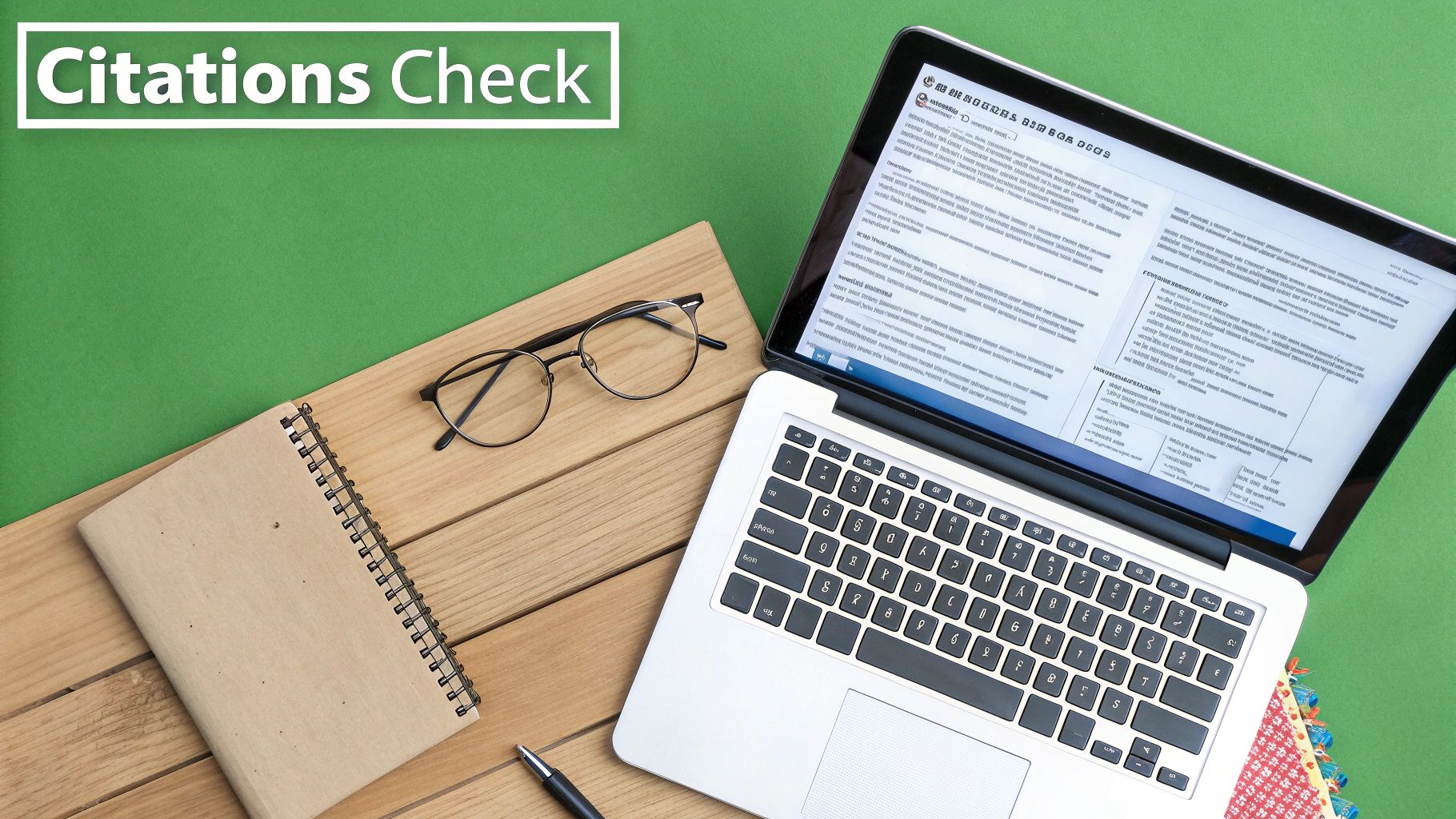
This is it—the last line of defense. After all the hard work structuring your argument and polishing your prose, the final proofread is a meticulous hunt for any straggling errors. Think of it as quality control. You’re here to catch the small but distracting mistakes that can undermine your credibility.
These are the sneaky typos, punctuation slip-ups, and formatting glitches that your brain has learned to ignore. Why? Because you're just too familiar with the text by now. The key is to trick your mind into seeing the paper with fresh eyes, as if for the first time.
How to Trick Your Brain into Spotting Errors
Your brain is incredibly efficient. So efficient, in fact, that it automatically corrects what you read, especially when it's your own work. To get around this, you have to disrupt your normal reading process. A few simple changes can make those lingering mistakes suddenly jump right off the page.
Here are a few proven techniques I always recommend:
- Read your paper aloud. This is a classic for a reason. Hearing your words spoken forces you to slow down. You'll catch awkward phrasing, run-on sentences, and missing words that your eyes would otherwise glide right over.
- Change the visual format. A quick visual shake-up can work wonders. Temporarily change the font, text size, or even the background color of your document. The text will feel unfamiliar, helping you spot errors you’ve become blind to.
- Read it backward. It sounds strange, but it works. Reading your paper sentence by sentence—from the very last one to the first—disrupts the logical flow your brain expects. This forces you to focus only on the mechanics of each individual sentence, not the story it tells.
This stage requires intense focus. It’s exactly why getting a second person to review your work is so valuable. A fresh pair of eyes doesn't have the same mental shortcuts and will almost always catch things you've missed after hours of editing.
Knowing When to Call in a Professional
Sometimes, a quick review from a friend isn't enough, especially for high-stakes documents like a thesis, a major business report, or content you plan to publish. This is where professional editing services become a powerful asset.
And it seems more people are catching on. The global proofreading and editing service market was valued at around USD 0.77 billion and is projected to more than double to USD 1.65 billion by 2033. This growth highlights a widespread understanding that error-free communication is essential for making a real impact. You can dig into the data yourself by exploring the full market report on businessresearchinsights.com.
A professional editor does more than just fix typos. They ensure your message is received without distraction, elevating your paper from good to genuinely excellent.
Your Final Pre-Submission Checklist
Before you finally hit "send" or "print," run through one last methodical check. Don't rush this part.
- Check all formatting. Make sure your margins, font size, spacing, and page numbers match the required guidelines. No exceptions.
- Verify citations and references. Double-check that every single citation in your text corresponds to an entry in your reference list, and vice-versa. This is a common and costly mistake.
- Confirm names and numbers. Scrutinize all proper nouns, dates, and statistics for accuracy. A single misplaced digit can turn a fact into fiction.
- Do a final "find" search. Quickly search for common mistakes you know you tend to make, like mixing up "its" and "it's" or leaving extra spaces after periods.
This final, meticulous pass is what separates a solid draft from a flawless final product. It’s the finishing touch that honors all the effort you’ve put in.
Common Questions About Editing a Paper
So you've finished your draft. Now what? The editing process can feel a little murky, and it's easy to get tangled up in questions. How long should you really wait before diving in? What’s the actual difference between editing and proofreading? And when should you trust a tool versus a human expert?
Getting these answers straight is the key to editing your paper effectively. Let's clear up some of the most common hurdles writers run into.
How Long Should You Wait Before Editing?
This one is critical: you have to give yourself some distance from your draft. I always recommend waiting at least 24 hours, but a few days is even better. This "cooling off" period is what gives you a fresh perspective.
When you're too deep in your own writing, your brain has a funny way of filling in the gaps. It reads what you meant to say, not what’s actually on the page. That short break makes it so much easier to spot awkward phrasing, logical holes, and typos you were blind to before.
If you're working on something major, like a dissertation or a huge report, taking a full week off is a smart move. Trust me, it’s an investment that pays off.
The Real Difference Between Editing and Proofreading
People throw these terms around as if they're the same thing, but they're not. They’re two completely different stages with different jobs. Nailing this distinction is fundamental to knowing how to edit a paper the right way.
I like to think of it like building a house:
- Editing is the big-picture work—the architecture and interior design. You’re focusing on structure, the strength of your argument, clarity, flow, and overall style.
- Proofreading is the final inspection before you hand over the keys. It’s a surface-level check for objective mistakes like typos, grammatical errors, and punctuation goofs.
Editing is about improving the substance and quality of your writing. Proofreading is about catching the small, pesky errors right before you send it out into the world. You should always edit first, then proofread.
AI Tools Versus Human Editors
Deciding between an AI tool and a human editor really comes down to what you're working on and how high the stakes are.
AI tools are fantastic for quick, low-cost checks. They’re great for running through everyday writing or very early drafts to catch common grammatical mistakes and typos. But when it comes to a critical document—a research paper, a thesis, or a business proposal—a human editor brings a level of insight that technology just can't replicate yet.
A person understands nuance, context, and your audience in a way an algorithm can’t. They can give you meaningful feedback on the strength of your argument, not just your comma placement. My advice? Use AI for a first pass, but always consider a human expert for the final polish on work that truly matters.
Ready to bridge that gap between a rough AI draft and polished, human-sounding writing? Natural Write instantly refines your text for clarity and tone, making sure it flows naturally and bypasses AI detection. Perfect your paper with one click at https://naturalwrite.com.
